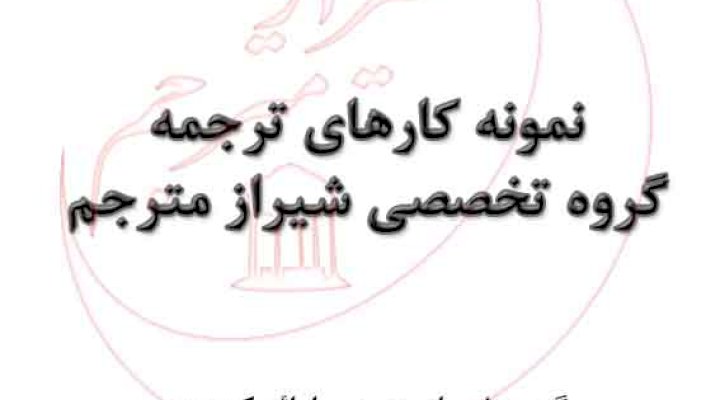نمونه ترجمه محیط زیست

مدیر قره زاده
جمعه 8 بهمن 1395
زمان مطالعه 7 دقیقه
The consequences of global pollution from improper manage- ment and disposal of obsolete electronics products known as scrap electronics (e-scrap) is a growing concern. According to a recent study by the U.S. Environmental ProtectionAgency (EPA), 40%ofthe lead in U.S. landfills is from discarded e-scrap (DFC, 2009). Another study finds that the average lifetime of a personal computer was 6 years in 1997 but 2 years in 2005 (Greenpeace, 2009); the dramatic change indicates that e-scrap is expected to reach 90 million tons in 2016, up from 40 million tons in 2011 (MarketsandMarkets.com, 2011). In Taiwan alone, about three million e-scrap products were recycled in 2010 (RFMB, 2011).
improve the environmental performance of energy-related products (European Commission, 2013). Other governments have turned to the use of incentives and subsidies. For example, the Taiwan EPA requires the electronics products manufacturers, importers and sellers (MIS firms) to pay the e-scrap products processing fee, called an advanced recycling fee (ARF), to support recycling. In Taiwan, consumers can bring their e-scrap products to designated recyclers and receive a financial reward. To compensate recyclers for the costs of recycling and processing the e-scrap,the Taiwan EPAuses theARF funds collected to subsidize the recyclers on the basis of the fund’s balance. This ARF is similar to one enacted by California, which assigns an ARF of $8–25 on all e-scrap containing hazardous materials depending on the viewable screen size (CalRecycle, 2009). Canada and Japan have implemented similar programs (Hicks et al., 2005; HP, 2005;Lee et al., 2000). Some countries incorporate a fee structure into their take-back programs. Allcock et al. (2010) reviews the financing and infrastructure model characteristics of different countries; for example, consumers or producers now pay fees similar to ARFs in Switzerland, Norway, Netherlands, Sweden, Japan, and Australia. Shinkuma (2003) investigates the relationship between the ARF and unit price of products, whereby the sum of the ARF and unit price is equalto the marginal disposal cost,thus attaining the social optimum. Puig-Ventosa (2004) presents a “feebate” (fee + rebate) structure that allows municipalities to improve waste management performance via its adoption.The literature has been supportive of such regulatory instruments. Foulon et al. (2002) indicate that certain regulationstandards need to be imposed to reflect current social responsibility policies. Chen and Sheu (2009) demonstrate that proper design of environmental-regulation pricing strategies can be applied to the firms insupply chains. FullertonandWolverton(1997) only analyze the usefulness of taxation and subsidization, which can affect different aspects of closed-loop supply chains, e.g. development and adoption of advanced pollution abatement technology (Jung et al., 1996), waste reduction and reuse (Conrad, 1999), market structure and welfare (Cremer and Thisse, 1999), deposit-refund systems (Kulshreshtha and Sarangi, 2001), environmental quality of products (Bansal and Gangopadhyay, 2003), and policy for green design (Fullerton and Wu, 1998).
اثرات آلودگی جهانی به واسطه ی مدیریت واردات و انهدام محصولات الکترونیکی فرسوده معروف به ضایعات الکترونیکی (e-scrap) موجب نگرانی عمده ای شده است. طبق مطالعات انجام شده اخیر توسط آژآنس حفاظت محیط زیست ایالات متحده (EPA)،40 درصد از رسوب محل دفن زباله های ایالات متحده ناشی از ضایعات الکترونیکی دورانداخته شده (2009،DFC) می باشد.بررسی دیگر نشان می دهد که میانگین عمر یک رایانه شخصی در سال 1997، 6 سال بوده است اما درسال 2015 این مقدار به دو سال کاهش یافته است.(2009Greenpaece)؛ طبق این تغییر چشمگیر انتظار میرود که در سال 2011 ضایعات الکترونیکی به 90 میلیون تن افزایش یابد. تنها در تایوان، حدود 3 میلیون ضایعات الکترونیکی در سال 2010 بازیافت شده است. برای به رسمیت شناختن اهمیت این مشکل، برخی دولت ها راه حل های بسیاری را پیشنهاد کردند. برای مثال ، اتحادیه اروپا، مسولیت جمع آوری، بازیافت و مرتب کردن ضایعات الکترونیکی را به تولیدکنندگان محول کرده است. بخشنامه منع معاملات مواد خطرناک(RHS)، استفاده از مواد خطرناک مشخص به عنوان موادخام برای تولید محصولات جدید را منع کرده است و نیازمندیهای بومی برای محصولاتی که انرژی مصرف می کنند (EUP) باعث می شود که بومی آرایی موجب بهبود عملکرد زیست محیطی محصولات وابسته به انرژی شود. دولت های دیگر با استفاده از پاداش و یارانه به حل این مشکلات پرداخته اند. برای مثال،EPA تایوان به تولیدکنندگان محصولات الکترونیکی و واردکنندگان و فروشندگان (MIS) نیاز دارد که برای پرداخت بهای تهیه محصولات ضایعات الکترونیکی بایستی بهای بازیافت آنها پرداخت گردد.
در تایوان، مصرف کنندگان میتوانند ضایعات الکترونیکی خود را به بازیافت کنندگان تحویل دهند و هدایای مالی دریافت کنند. برای پاداش دادن به بازیافت کنندگان برای مخارج بازیافت و تهیه ضایعات الکترونیکی، EPA تایوان از هزینه های بازیافت پیشرفته (ARF) برمبنای توازن مالی جمع آوری شده استفاده میکند.
مانند این مورد (ARF) در کالیفرنیا نیز تصویب شده است که یک برای تمام ضایعات الکترونیکی که دارای مواد خطرناک هستند قوانین خاصی مشخص شده است. کانادا و ژاپن نیز برنامه های مشابهی را برای این مسئله پیاده کرده اند. بعضی کشورها ساختار هزینه را با برنامه های پیشرو هماهنگ میکنندAllcock et a (2010). که در آن زیر ساخت ها و سرمایه گذاری کشورهای مختلف را خلاصه میکند.
Puig-ventosa (2004)یک (تخفیف هزینه =feebate)را ارائه کرده است ساختاری که به شهرداری ها اجازه میدهد که عملکرد مدیریت ضایعات را گسترش دهند مطبوعات همیشه چنین ابزارهای نظم دهنده را حمایت کرده است.
ثبت سفارش ترجمه
مترجم: سحررهبرعالم
در بالا متن تخصصی رشته محیط زیست و ترجمه آن آمده است. ترجمه تخصصی رشته محیط زیست توسط فارغ التحصیلان محیط زیست صورت میگیرد. تمامی متون ترجمه شده توسط ناظرین گروه تخصصی شیراز مترجم مورد بررسی قرار میگیرد.
برچسبها: نمونه ترجمه محیط زیست،نمونه ترجمه،زمین شناسی،ترجمه ارزان،نمونه ترجمه ارزان،ترجمه با کیفیت،ترجمه محیط زیست،ثبت سفارش ترجمه نمونه ترجمه محیط زیست،ثبت سفارش ترجمه

 استخدام
استخدام ورود به حساب کاربری
ورود به حساب کاربری














